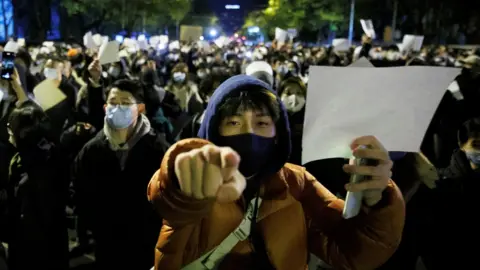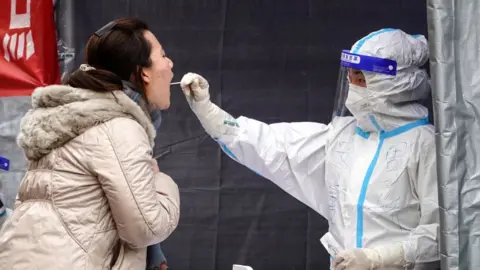China Covid protests: Fury and fear of virus puts Xi Jinping in a bind
 Reuters
ReutersFor the past three years, the patience of one billion people in China has been stretched, growing thinner and thinner with every lockdown and round of mass Covid testing.
Now, that patience has snapped.
As thousands took to the streets in cities protesting against Covid restrictions, an exhausted nation has been asking how much longer must they endure Xi Jinping's zero-Covid policy.
In one of President Xi's biggest political tests yet, the Chinese Communist Party (CCP) must now negotiate both mounting fury and a deep-rooted fear of Covid, as the country feels its way to an exit from the pandemic.
A fire that lit public anger
An apartment fire in the western city of Urumqi may at first appear to be an unlikely spark for nationwide protests.
But the deadly incident, which claimed the lives of 10 people, was the ultimate nightmare scenario for millions of urban Chinese who live in high-rise apartments: trapped in one's flat, unable to escape a roaring blaze because of a strictly enforced lockdown.
Authorities disputed this, but it did not stop public outrage and anxiety from spreading, especially after videos and audio clips purportedly featuring residents screaming and begging to be released circulated online.
The incident was also the latest in a series of horror stories linked to Covid restrictions.
Early on, during city-wide lockdowns, reports surfaced of pregnant women losing their babies and the old and vulnerable dying, because of a lack of timely access to medical care.
Many lockdowns also seemed to have the same stories of food and medicine shortages, as it became clear that local authorities were struggling to cope.
Then, more traumatic incidents began to emerge, such as a bus crash that killed dozens of people who were being ferried to quarantine centres, or children dying in quarantine facilities.
Many hoped there would be a reprieve announced at the recent CCP congress where Mr Xi cemented his power, but he made it clear there would be no change to zero Covid, provoking more dismay.
The policy has no doubt saved many lives, with China achieving one of the lowest per capita Covid death rates in the world. But it has also sapped the energy of its people.
Suffering under Covid restrictions has become a unifying experience, breeding anger in many corners of China from major cities to far-flung regions like Xinjiang and Tibet.
It has galvanised every part of society including university students, factory workers, middle-class families, and the elite.
 Getty Images
Getty ImagesWhen a man staged a protest on a Beijing bridge, shocking the country with its openly defiant criticism of President Xi, it set the bar for the expression of more direct and sharper dissent both outside and within China, emboldening many others.
In the central city of Zhengzhou, hundreds of factory workers called for their rights and scuffled with police, as they smashed surveillance cameras and windows. In Chongqing in the south-west, a maskless man was filmed shouting "Give me liberty, or give me death!" - a rallying cry picked up by many protesters.
By the time the Urumqi fire happened, the stage was set for widespread demonstrations. Hundreds first took to the streets in that city, then many more followed suit in Shanghai, Beijing, Wuhan, Nanjing and Chengdu, some even calling for Mr Xi and the CCP to step down.
This was previously unthinkable in a country that heavily punishes and censors anyone critical of the party and its leaders.
Observers say the protests are a tipping point in Covid dissent, complicating a situation that is already difficult for the government.
Ho-fung Hung, a sociologist with Johns Hopkins University, said they presented "a dire situation" and the first serious test to Mr Xi's rule.
"Over the last two years Mr Xi backed himself into a corner by owning the zero-Covid policy. The most rational way for him to handle the situation if protests continue to grow is to pressure local authorities to crack down hard while distancing himself.
"But then there is a risk that local authorities might refuse to follow the directive closely as they are worn down by the zero-Covid rigidities too."
Fear and loathing of Covid
So could the government listen to the protesters, and unwind zero Covid?
To do that now - while minimising deaths and infections - would be difficult, due to the country's low vaccination rates among the elderly, a lack of highly effective domestic vaccines, and the government's continued refusal to follow the rest of the world in using foreign vaccines.
"There's a dilemma for the government," Oxford University professor of modern Chinese history Rana Mitter told the BBC - do they import foreign vaccines "which may look embarrassing in nationalistic terms or do they try to hold the line by keeping the borders closed without any end date for this policy?"
China recently appeared to test the waters by loosening measures slightly, where they reduced some quarantine periods and stopped recording secondary contacts.
But, as seen in other countries such as Singapore and Australia which transitioned from zero Covid to living with the virus, any relaxation of measures would inevitably result in a jump in infections and deaths.
This is an outcome which Chinese authorities still appear unwilling to accept.
Many cities including Beijing and Guangzhou have once again put in place restrictions to tackle fresh outbreaks, even though experts have warned it is difficult to maintain zero Covid for the long term given the virus' rapid evolution and government's finite resources.
"Even if the government wants to change course now, it still has to address the rapid surge of cases nationwide. The problem is that it no longer has adequate state capacity or public support to contain the spread of the virus," said Yanzhong Huang, senior fellow for global health at the Council on Foreign Relations.
Part of the problem is the fear among officials that Covid deaths will spiral out of control and cause social unrest.
But there is also the lingering fear of Covid among the Chinese - after three years of being conditioned by the state to view the virus as a fearsome enemy - as well as a continued lack of effective vaccines.
In recent weeks, rumours spread in the city of Shijiazhuang and the Foxconn factory complex in Zhengzhou that residents would be used as "guinea pigs" to see what would happen if Covid was allowed to spread unchecked.
In both places this prompted widespread panic and even led Zhengzhou workers to stage a mass breakout.
For some, this fear has now been replaced by anger. In recent demonstrations, protesters have gathered in huge, dense crowds with some defiantly taking off their masks, as they call for freedom and restrictions to end.
When and how that will happen exactly still remains unclear.
Mr Xi and the Chinese Communist Party have created a Covid Gordian knot - one that is now extremely difficult to cut.
